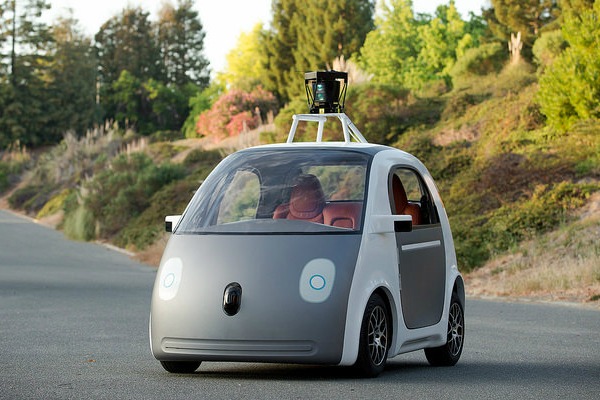Self-driving cars present myriad of obstacles

Google began testing its new driverless cars on Bay Area roads in 2015. Google plans to make the vehicles available to the public as soon as 2019. Photo courtesy Flickr user SmoothGroover22.
In the past few years, it has become more common to see Google’s self-driving cars cruising the streets of Los Altos and Mountain View; many students often spot the vehicles during their morning or afternoon commute. The autonomous cars have been making news as one of the biggest advancements in day-to-day technology that the public might expect to see in 2019.
Proponents of the project cite the cars’ superior safety, potential for more efficient transportation and ability to free up valuable time for their passengers. While the technology does present a strong initial appeal, it ultimately reveals a multitude of problems that make it an impractical development. Self-driving cars will be unable to fully actualize their goals on roads dominated by human drivers and will create a logistical nightmare even if they were to take control of the streets.
Under current laws, self-driving cars and all other autonomous or semiautonomous road technology require more attention to operate than do their manual counterparts.
According to California Senate Bill 1298, “[A driver must be] seated in the driver’s seat, monitoring the safe operation of the autonomous vehicle, and capable of taking over immediate manual control of the autonomous vehicle in the event of an autonomous technology failure or other emergency.”
Consequently, a driver of an automated vehicle will not experience any practical benefits of the technology because the driver is, in essence, still operating the vehicle. The driver of an autonomous vehicle must pay attention to not only all the traffic and details he or she would in a conventional car, but also the movements of his or her own vehicle to ensure its safe operation. This renders the technology useless for all purposes.
As research and development continue, the legal requirement for drivers to sit at the wheel may be lifted and passengers may even be allowed to nap in the back seat. However, certain key aspects to road safety will be impossible to control even through legal means as long as autonomous vehicles must coexist with human drivers. John Lee, a professor of industrial and systems engineering at the University of Wisconsin, notes this discrepancy between humans and artificial intelligence.
“[Humans often resolve situations through] eye contact. On the fly, they make agreements about who has the right of way,” Lee said in an interview with The New York Times. “Where are the eyes in an autonomous vehicle?”
The obvious solution to this challenge is to simply avoid all contact between human drivers and the artificial intelligence. Infrastructure supporting this separation is where self-driving cars offer the greatest benefits ― it would effectively create a transportation “cloud” of networked vehicles that could safely and efficiently shuttle passengers to their destinations, possibly eliminating the need to own a vehicle or find parking spaces.
If the government and private companies find the resources to fund this model, self-driving cars will effectively supersede all other forms of motorized transport ― current public transportation will cease to exist, and few people will own their own vehicles. Whenever people need something moved, they will call upon a network of autonomous vehicles.
This driverless-taxi model certainly has attractive benefits. A controlled system completely driven by networked computers with instantaneous reactions means that the vehicles will be capable of safely traveling at higher speeds than they would if they were driven by humans.
Yet, governments will face enormous difficulties when drafting the infrastructure to accommodate this behavior. In the event that an unforeseen obstruction blocks the roadway, it might be physically impossible to avoid a collision at an increased speed.
And, for all the traffic safety the cars might provide, they still present security risks. Without the supervision of a driver, what would stop an ill-minded individual from rigging vehicles with explosives and using them as self-guided bombs? Or, how could the vehicles interface with one another without opening themselves to hacker attacks?
Even with these concerns, it seems inevitable that the development and deployment of autonomous vehicles will continue on their course. Whether the technology will be better than alternatives such as improved public transportation and supplemental infrastructure remains to be seen. Hopefully, Google and other companies will proceed slowly and cautiously enough so they do not compromise human safety for commercial success.


